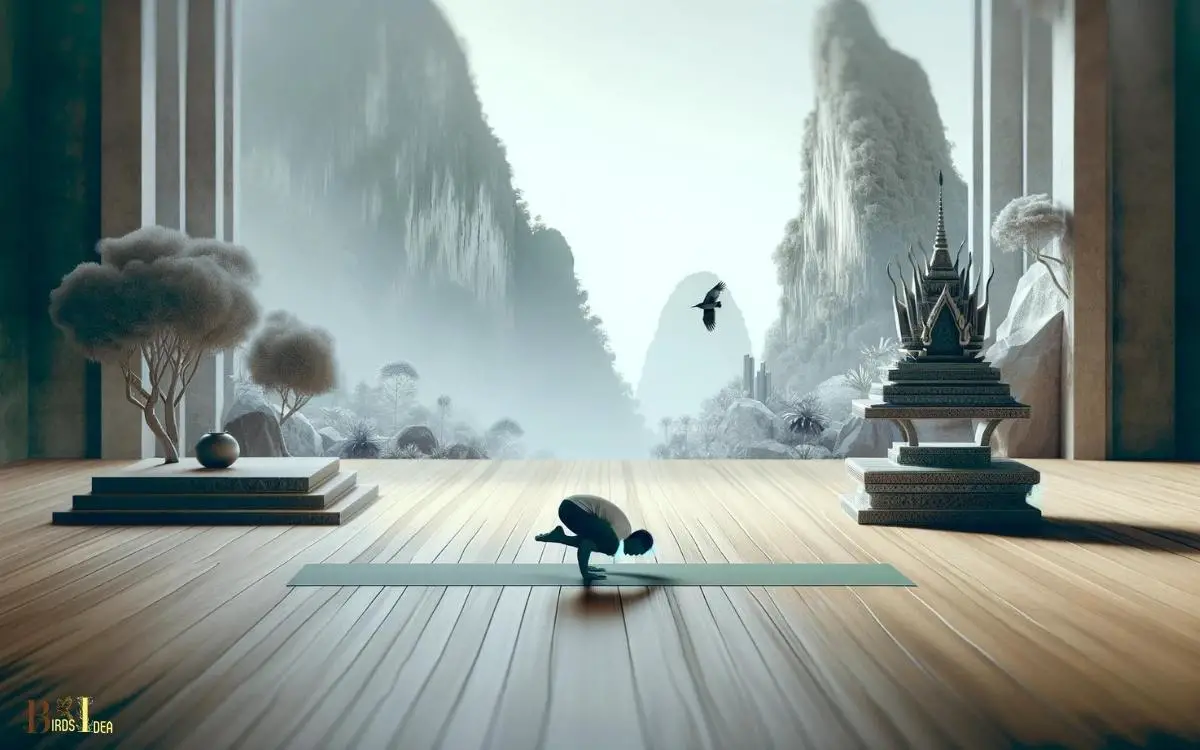What is Crow Pose? Discover!
The Crow Pose, or Bakasana, is a fundamental arm balance in yoga that challenges and refines balance, focus, and strength.
It involves squatting down with your hands flat on the ground, spreading your fingers for stability, and then carefully lifting your feet off the ground as you lean forward, balancing your knees on your upper arms.
Bakasana, commonly known as the Crow Pose, is a dynamic asana that combines the art of balance with physical strength. It is often introduced as one of the first arm balances in a yoga practice.
The key aspects of this pose include:
Mastering the Crow Pose serves as a gateway to more complex arm balances, enhancing core control and arm strength, which are essential components for advanced yoga practices.

Key Takeaway
Origin and Meaning of Crow Pose
The origin and meaning of Crow Pose can be traced back to the ancient discipline of yoga, where it holds significance as a symbol of balance and focus.
Also known as Bakasana in Sanskrit, this pose requires the practitioner to balance their body on their hands with the shins resting on the upper arms.
The name ‘Crow Pose’ is derived from the Sanskrit word ‘baka,’ which translates to ‘crow’ in English. In Hindu mythology, the crow is considered to be a symbol of the perfect balance between the physical and the spiritual.
This asana challenges the practitioner to find their center of gravity and focus their mind, embodying the essence of balance and concentration.
It is a posture that encourages inner strength and mental clarity, making it a powerful symbol of freedom within the practice of yoga.
Physical Alignment and Technique
Characterized by a strong focus on upper body strength and balance, achieving the physical alignment and technique for Crow Pose is essential for a successful execution of this challenging yoga asana.
To achieve the proper physical alignment and technique for Crow Pose, follow these key steps:
- Start in a squatting position with your feet close together.
- Place your hands on the ground shoulder-width apart, spreading your fingers wide for stability.
- Lift your hips and shift your weight forward onto your hands, keeping your elbows bent.
- Engage your core and lift your feet off the ground, bringing your knees as close to your armpits as possible while balancing on your hands.
Mastering these alignment and technique principles will allow you to confidently execute Crow Pose.
Now, let’s explore modifications and variations to accommodate different skill levels and body types.
Modifications and Variations
Achieving the proper physical alignment and technique for Crow Pose opens the door to exploring modifications and variations to accommodate different skill levels and body types.
For beginners, placing a yoga block under the forehead can provide additional support and stability as they work on finding their balance.
Those with wrist discomfort can try using yoga wheels under their hands to decrease the angle of the wrists.
Advanced practitioners can experiment with side crow, by shifting the weight to one side and extending the opposite leg.
Another variation involves transitioning from Crow Pose into a headstand or even a handstand.
These modifications and variations allow individuals to experience the benefits of Crow Pose while adapting the practice to suit their unique needs and abilities, providing a sense of freedom within the pose.
Benefits for the Body and Mind
Crow Pose offers numerous benefits for the body and mind, making it a valuable addition to any yoga practice.
Some of the key benefits include:
- Strengthens the arms, wrists, and core muscles, promoting overall physical strength and stability.
- Improves balance and concentration, enhancing mental focus and mindfulness.
- Stimulates the digestive organs, aiding in digestion and promoting a healthy metabolism.
- Builds confidence and determination as practitioners overcome fear and learn to trust their own strength and balance.
By incorporating Crow Pose into a regular yoga routine, individuals can experience physical and mental transformation, gaining strength, focus, and a sense of empowerment.
This powerful asana not only challenges the body but also nurtures the mind, offering practitioners a holistic sense of well-being and freedom.
Precautions and Safety Tips
When practicing Crow Pose, it is important to approach it with caution and mindfulness to prevent injuries and ensure safe execution of the asana.
Start by warming up your wrists, shoulders, and core muscles to prepare your body for the pose. For those with wrist issues, it’s advisable to use extra support or modify the pose.
Always listen to your body and never force yourself into the posture. Focus on engaging your core and using your breath to find stability.
It’s essential to practice Crow Pose on a non-slip surface to avoid any accidental slips. Additionally, having a spotter or practicing near a wall can provide a sense of security as you build confidence in the pose.
Conclusion
The crow pose is a challenging yoga posture that requires strength, balance, and focus. It has its origins in ancient yoga traditions and carries deep symbolic meaning.
Practicing crow pose can bring various physical and mental benefits, but it is important to approach it with caution and be mindful of any potential risks.
With proper alignment and modifications, individuals can safely explore this empowering pose in their yoga practice






